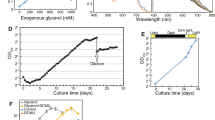Abstract
Rhodopseudomonas globiformis strain 7950 grew with a variety of amino acids, urea, or N2 as sole nitrogen sources. Cultures grown on N2 reduced acetylene to ethylene; this activity was absent from cells grown on nonlimiting NH +4 . Glutamate dehydrogenase could not be detected in extracts of cells of strain 7950, although low levels of an alanine dehydrogenase were present. Growth ofR. globiformis on NH +4 was severely inhibited by the glutamate analogue and glutamine synthetase inhibitor, methionine sulfoximine. High levels of glutamine synthetase (as measured in the γ-glutamyl transferase assay) were observed in cell extracts of strain 7950 regardless of the nitrogen source, although N2 and amino acid grown cells contained somewhat higher glutamine synthetase contents than cells grown on excess NH +4 . Levels of glutamate synthase inR. globiformis were consistent with that reported from other phototrophic bacteria. Both glutamate synthase and alanine dehydrogenase were linked to NADH as coenzyme. We conclude thatR. globiformis is capable of fixing N2, and assimilates NH +4 primarily via the glutamine synthetase/glutamate synthase pathway.
Similar content being viewed by others
Abbreviations
- GS:
-
glutamine synthetase
- GOGAT:
-
Glutamineoxoglutarate aminotransferase
- GDH:
-
Glutamate dehydrogenase
- ADH:
-
Alanine dehydrogenase
- MSO:
-
Methionine sulfoximine
References
Aretz W, Kaspari H, Klemme J-H (1978) Utilization of purines as nitrogen sources by facultative phototrophic bacteria. FEMS-Lett. 4:249–253
Bast E (1977) Utilization of nitrogen compounds and ammonia assimilation byChromatiaceae. Arch Microbiol 113:91–94
Bender RA, Janssen KA, Resnick AD, Blumenberg M, Foor F, Magasanik B (1977) Biochemical parameters of glutamine synthetase fromKlebsiella aerogenes. J Bacteriol 129:1001–1009
Brown CM, Herbert RA (1977a) Ammonia assimilation in members of the Rhodospirillaceae. FEMS-Lett. 1:43–46
Brown CM, Herbert RA (1977b) Ammonia assimilation in purple and green sulphur bacteria. FEMS-Lett. 1:39–42
Engelhardt H, Klemme J-H (1978) Characterization of an allosteric, nucleotide-unspecific glutamate dehydrogenase fromRhodopseudomonas sphaeroides. FEMS-Lett 3:287–290
Gest H, Kamen MD (1949) Photoproduction of molecular hydrogen byRhodospirillum rubrum. Science 109:558–559
Herbert RA, Siefert E, Pfennig N (1978) Nitrogen assimilation inRhodopseudomonas acidophila. Arch Microbiol 119:1–5
Herbert RA, Siefert E, Pfennig N (1980) Utilization ofL-alanine byRhodopseudomonas acidophila. Arch Microbiol 125:105–109
Herbert RA, Westwater SA (1981) Nitrogen assimilation in a methanolutilising strain ofRhodopseudomonas acidophila. FEMS-Lett 12:183–186
Imhoff JF, Then J, Hashwa F, Trüper HG (1981) Sulfate assimilation inRhodopseudomonas globiformis. Arch Microbiol 130:234–237
Johansson BC, Gest H (1976) Inorganic nitrogen assimilation by the photosynthetic bacteriumRhodopseudomonas capsulata. J Bacteriol 128:683–688
Johansson BC, Gest H (1977) Adenylylation/deadenylylation control of the glutamine synthetase ofRhodopseudomonas capsulata. Eur J Biochem 81:365–371
Lowry OH, Rosebrough NJ, Farr AL, Randall RJ (1951) Protein measurement with the Folin phenol reagent. J Biol Chem 193:265–275
Madigan MT, Gest H (1979) Growth of the photosynthetic bacteriumRhodopseudomonas capsulata chemoautotrophically in darkness with H2 as the energy source. J Bacteriol 137:524–530
Madigan MT, Wall JD, Gest H (1979) Dark anaerobic dinitrogen fixation by a photosynthetic microorganism. Science 204:1429–1430
Meyer J, Kelley BC, Vignais PM (1978) Nitrogen fixation and hydrogen metabolism in photosynthetic bacteria. Biochimie 60:245–260
Pfennig N (1974)Rhodopseudomonas globiformis, sp. n., a new species of the Rhodospirillaceae. Arch Microbiol 100:197–206
Ronzio RA, Meister A (1968) Phosphorylation of methionine sulfoximine by glutamine synthetase. Proc Natl Acad Sci U.S.A. 59:164–170
Schmidt K, Liaaen-Jensen S (1973) Bacterial carotenoids. XLII: New ketocarotenoids fromRhodopseudomonas globiformis (Rhodospirillaceae). Acta Chem Soand 27:3040–3052
Siefert E, Pfennig N (1980) Diazotrophic growth ofRhodopseudomonas acidophila andRhodopseudomonas capsulata under microaerobic conditions in the dark. Arch Microbiol 125:73–77
Then J, Trüper HG (1981) The role of thiosulfate in sulfur metabolism ofRhodopseudomonas globiformis. Arch Microbiol 130:143–146
Gemerden H, van (1968) Growth measurements ofChromatium cultures. Arch. Mikrobiol 64:103–110
Wagner BJ, Miović ML, Gibson J (1973) Utilization of amino acids byChromatium sp. strain D. Arch Mikrobiol 91:255–272
Wall JD, Johansson BC, Gest H (1977) A pleiotropic mutant ofRhodopseudomonas capsulata defective in nitrogen metabolism. Arch Microbiol 115:259–263
Author information
Authors and Affiliations
Rights and permissions
About this article
Cite this article
Madigan, M., Cox, S.S. Nitrogen metabolism inRhodopseudomonas globiformis . Arch. Microbiol. 133, 6–10 (1982). https://doi.org/10.1007/BF00943761
Received:
Accepted:
Issue Date:
DOI: https://doi.org/10.1007/BF00943761




